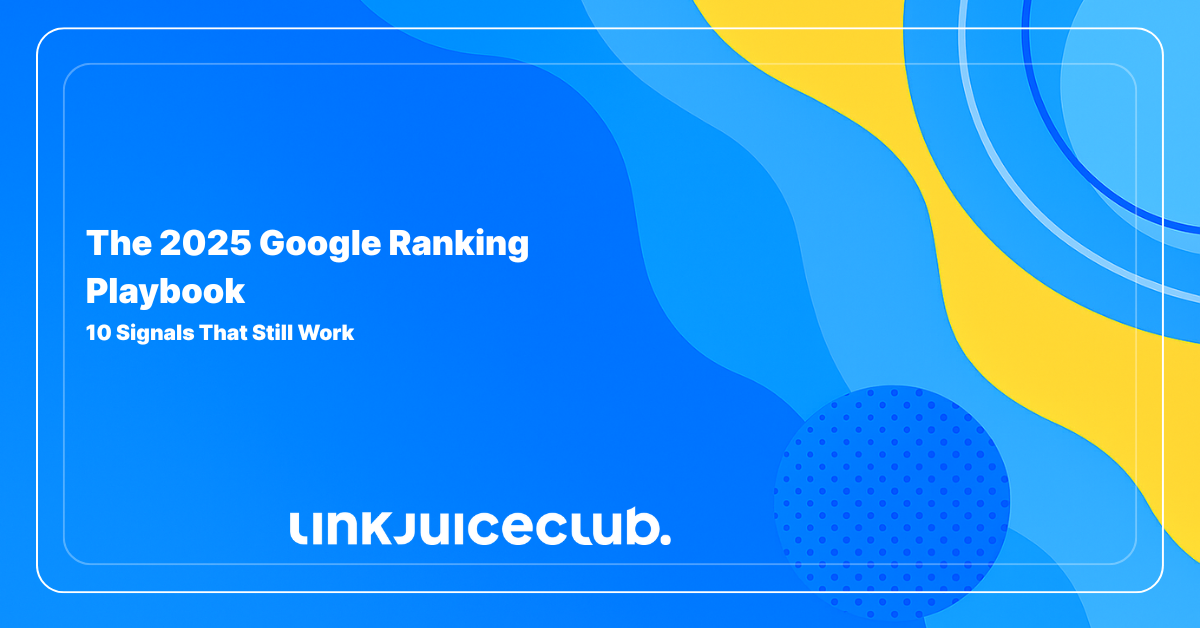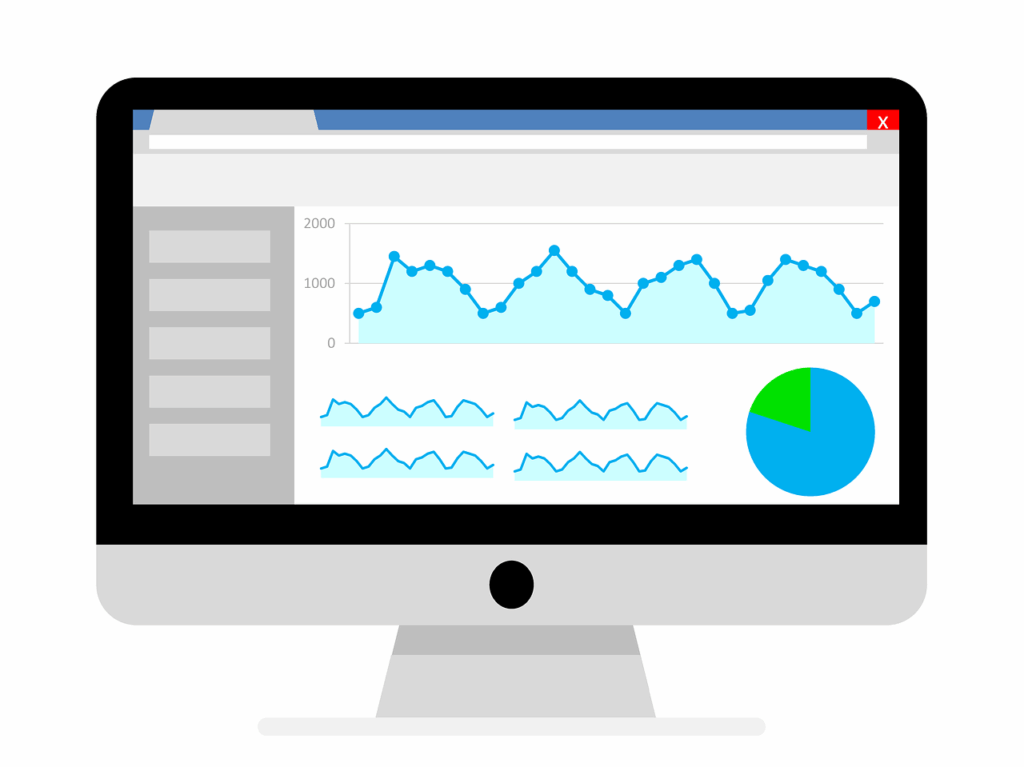
The 2025 Google Ranking Playbook: 10 Signals That Still Work
There’s SEO theory, and then there’s what actually gets you ranked. Spoiler: Google’s got over 200 ranking signals—but you don’t need to chase them all.
Most of them barely move the needle. What does matter? A core group of factors that tell Google, “This content slaps. Show it off.”
This guide cuts through the noise and gives you the real-world signals you should be focused on in 2025.
What Even Is a Google Ranking Factor?
Let’s start at the top. A Google ranking factor is anything Google uses to decide how high your content shows up in search results.
It’s the algorithm’s way of saying, “This page deserves to be seen—or not.”
These factors include things like:
- Keywords (do you mention what people are searching for?)
- Page speed (is your site painfully slow?)
- Backlinks (do other sites vouch for you?)
- Mobile-friendliness (can users navigate your site with their thumbs?)
There are over 200 known ranking signals. Some carry more weight than others. Some change constantly. But all of them help Google figure out which pages actually answer a user’s question, and which don’t.
Example? Someone types “best WordPress theme” into Google. The algorithm goes hunting for pages that are helpful, recent, keyword-optimized, and trusted. Then it stacks them based on how well they tick those boxes.
It’s less about chasing a perfect formula—and more about creating an experience that Google (and users) trust.
What Are the Most Important Google Ranking Factors?
Here’s the truth: you can’t optimize for everything—and you don’t need to.

Skip the fluff. Here are the 10 Google ranking factors that matter in 2025—and how to actually use them.
With over 200 ranking signals in play, it’s tempting to treat SEO like a never-ending checklist. But perfection isn’t the goal. Prioritization is. That’s why we built this guide.
The ranking factors you’re about to see aren’t just theory. They’re the ones that consistently drive visibility, clicks, and conversions—across industries, niches, and content types.
They’re the “big levers” in the SEO machine.
So instead of getting lost in the weeds, focus your efforts here. These are the factors worth sweating over. And once you’ve got them down, you’ll already be ahead of 90% of your competition.
1. High-Quality Content (Still King. Still Unskippable.)
Let’s be real—content is the make-or-break factor. In 2025, Google expects more than just surface-level value. It wants you to actually help someone. No, not just regurgitate info that’s been repeated across 50 other blogs.
This means your content should be:
- Original: No copying, no reworded fluff.
- Detailed: Address all angles of the topic.
- Experience-driven: Show you’ve been there, done that.
If you’re writing about how to start a podcast, don’t just list 10 steps. Talk about your first mic, how awkward your first episode was, and how you grew your first 100 listeners. That’s content that connects.
Use formatting to your advantage. Short paragraphs, bold takeaways, numbered steps—these help readers absorb information fast. And fast comprehension = longer dwell time.
Update regularly. Outdated stats and broken links are red flags. Evergreen posts still need pruning. When Google sees that you’re active, it assumes you care.
And remember: good content isn’t about you. It’s about the reader. Solve their problem and make them feel like you read their mind.
2. Backlinks (The Internet’s Trust Currency)
Backlinks are still one of Google’s heaviest ranking weights—and that won’t change anytime soon.
But here’s what has changed: spammy link building is dead. Google’s link spam update in late 2023 cleaned house. Now, only quality links from relevant, trusted sites pass value.
What counts as a quality backlink?
- It comes from a site with topical relevance to yours.
- It’s from content, not a sidebar or footer.
- It’s earned organically (not obviously paid or traded).
Want to earn more? Create data-driven content, original research, or unique visuals that people want to cite. Pitch journalists on HARO. Partner with aligned brands. Write guest posts that actually teach something new.
Oh, and internal linking matters too. Use it to keep users flowing through your site and pass authority to your deeper pages.
If backlinks are votes, make sure your campaign is worth electing.
3. Search Intent (Read the Room)
If someone searches “best laptops for college students,” they don’t want a tutorial on how laptops work. They want a comparison list. Miss that intent, and it doesn’t matter how optimized your page is—Google’s not showing it.
There are four main types of intent:
- Informational: Just looking to learn something.
- Navigational: Looking for a specific brand or site.
- Transactional: Ready to buy.
- Commercial Investigation: Researching before buying.
Your job? Understand which bucket your keyword fits into. Then, create content that directly satisfies that intent. Bonus points if you include content formats Google clearly prefers for that query (e.g., videos, carousels, listicles).
Intent matching is more than just a strategy—it’s table stakes now.
Tip: Look at the SERP before you write anything. It’s the blueprint.
4. Page Speed (Speed Isn’t Everything—But It’s Close)
Fast pages win. Not just because Google says so, but because users say so with their clicks, swipes, and exits.
Google’s Core Web Vitals (Largest Contentful Paint, First Input Delay, and Cumulative Layout Shift) are still in play. But in 2025, responsiveness and interaction quality are being weighed even more.
Here’s what slows you down:
- Huge image files
- Render-blocking JavaScript
- Excessive third-party scripts
- Slow hosting
Fix it with:
- WebP images
- Lazy loading
- Cloudflare or another CDN
- Minimal, efficient themes (especially for WordPress)
Test with PageSpeed Insights or GTmetrix regularly. Use the feedback. And don’t forget mobile speeds—because Google definitely won’t.
5. Mobile Friendliness (Your Site’s Real First Impression)
Mobile traffic dominates. Your mobile site isn’t a sidekick anymore—it’s the main event.
Your site needs to be:
- Responsive: Adjusts perfectly to every screen size.
- Readable: No zooming or squinting.
- Interactive: Buttons, menus, forms—all must work seamlessly.
Use Google’s Mobile-Friendly Test tool. If your site fails it, you’re already behind. Users expect smooth, app-like experiences. Google expects the same.
Design with mobile-first principles. That means starting your layout for small screens, then scaling up to desktop—not the other way around.
6. Domain Authority (Clout, Earned Not Bought)
Domain Authority (DA) is a score, yes. But what it really represents is trust.
You gain DA by being consistent, focused, and helpful. You lose it by being inconsistent, scattered, and spammy. DA is influenced by your backlink profile, but also your topical depth and structure.
Here’s how to grow it:
- Stay in your lane (one core topic = better rankings)
- Build topic clusters (pillar pages + supporting blogs)
- Get mentioned by authorities in your space
The more you double down on your subject matter, the more Google will associate your site with expertise in that area.
7. Keyword Optimization (Still Worth Doing—If You Do It Right)
Keyword optimization isn’t about keyword count, it’s about keyword context.
You should still include your main keyword in the title, first paragraph, meta description, and at least one subheading. But you also need to:
- Use synonyms and variations naturally
- Cover related questions (People Also Ask)
- Add keywords to image alt text
- Structure content semantically with proper headers
Google is smarter now. It uses machine learning and NLP to understand what your page means. So yes, keywords matter—but they’re not magic spells.
If it reads like a conversation, you’re doing it right.
8. Website Structure (If Google Gets Lost, You Don’t Rank)
Think of your website like a building. If the rooms are randomly connected and the hallway leads nowhere, people, and search engines, won’t stick around.

That’s where site structure comes in. A clean, organized structure helps Google understand what your site is about, how your content connects, and which pages are most important.
And yes, structure is a legit ranking factor. Google uses automated bots (aka crawlers or spiders) to scan the web. But they’re not magical. They follow links, look at hierarchies, and rely heavily on your architecture to find, index, and rank your pages.
A good structure:
- Helps Google crawl efficiently
- Prioritizes your most valuable content
- Prevents orphan pages (pages with no internal links)
- Improves UX for human visitors too
A bad structure? It hides your best content, wastes crawl budget, and confuses everyone.
Keep It Flat, Not Deep
A flat website architecture means users (and Google) can get to any important page in 3 clicks or less. That’s the goal.
Avoid endless subfolders like:
yourdomain.com/blog/category/2025/june/how-to-write-seo-content
Instead, simplify:
yourdomain.com/seo-content-guide
Less is more.
Use Internal Linking Like a Pro
Internal links help Google understand the relationships between your pages—and they pass SEO value along the way.
Want a page to rank? Link to it from other high-traffic pages. Use descriptive anchor text, not generic terms like “click here.” And don’t forget to link between related blog posts to keep people moving through your content funnel.
Tip: Create topic clusters. Start with a “pillar page” that covers a topic broadly, and support it with deeper subpages that answer specific questions. Then interlink them all.
Don’t Skip the Sitemap
A sitemap is exactly what it sounds like: a roadmap for search engines.
It tells Google which pages exist, which are most important, and when they were last updated. You can easily generate one with tools like Yoast, All in One SEO, or Rank Math—especially if you’re on WordPress.
Bonus: You can create multiple sitemaps for different content types—like blog posts, videos, or news. Google loves it when you make its job easier.
Tidy Up Your Robots.txt
Your robots.txt file is like a bouncer for Googlebot. It tells crawlers what they can index—and what they should ignore.
Done right, it prevents Google from wasting time on useless pages like:
- Login/admin panels
- Shopping cart pages
- Internal search results
That way, more crawl energy is focused on the content that matters—your landing pages, blog posts, and high-converting URLs.
TL;DR: Structure Is Silent SEO Power
Site structure doesn’t scream for attention like a flashy title tag. But it’s one of those behind-the-scenes signals that quietly makes everything else work better.
When your site is well-organized, content gets discovered faster, ranked higher, and served more often to users who actually want it.
So before you add your next blog post or product page, ask yourself:
“Can Google find this? Does it know where this fits? Is this connected to the rest of my site?”
If the answer is yes—you’re doing it right.
9. HTTPS (No SSL? No Love.)
HTTPS isn’t a bonus anymore, it’s mandatory.
If your site still uses HTTP, Google is warning users about security risks. That alone can tank your trust factor. And if users bounce? Rankings drop.
Install an SSL certificate. Most web hosts offer them free via Let’s Encrypt. Redirect all traffic to HTTPS. Update your Search Console and internal links accordingly.
One quick fix, huge credibility boost.
10. On-Page Experience (Because Google Watches What Visitors Do)
This one’s simple: if people hate using your page, Google won’t send them more traffic.
On-page experience is Google’s way of measuring how real humans interact with your site—beyond the code, the keywords, and the links. It looks at how people behave once they land on your content. And it’s a powerful ranking signal.
So how does Google know if users love or leave your content? Let’s break it down:
CTR (Click-Through Rate)
This is where the journey starts. CTR tells Google how many people see your page in the search results—and how many are intrigued enough to click it.
A low CTR means your title and meta description aren’t compelling, even if you’re ranking decently. A high CTR? That’s a signal to Google that your result looks relevant and attractive—and maybe deserves to rank even higher.
Fix it:
- Write punchier, benefit-driven titles.
- Use power words, numbers, or urgency (“10 Proven Tactics”, “Complete 2025 Guide”).
- Craft meta descriptions that promise value and match search intent.
Bounce Rate
Bounce rate measures how many people land on your page and then immediately back out without engaging.
A high bounce rate says one of two things:
- Your content wasn’t what they expected, or
- Your page was confusing, slow, or flat-out unhelpful.
Neither is good news.
- Match search intent perfectly (e.g., listicle for “best tools”, how-to for “how to fix…”).
- Improve visual hierarchy—headings, bullet lists, clear CTAs.
- Remove intrusive popups or layout shifts that frustrate visitors.
Dwell Time
Dwell time is gold. It tells Google how long someone stays on your site after clicking from search results.
Longer dwell time = more engaged users = content that’s actually helpful. Google likes that. A lot.
Fix it:
- Start strong. Your intro needs to hook the reader within seconds.
- Use internal links to keep people exploring your site.
- Embed visuals, videos, quotes, or interactive tools to create a richer experience.
TL;DR: Want to Rank in 2025? Do the Stuff That Matters
Forget the noise. These 10 signals still rule the SERPs:
- Content that solves real problems
- Links from legit, relevant sites
- Pages that match what searchers actually want
- Fast loading, mobile-friendly, secure design
- Structure that makes sense
- Behavior that shows users stick around
It’s not about tricking Google. It’s about serving your audience so well, Google has no choice but to notice.
Be useful. Be intentional. Be excellent. Rankings will follow.





